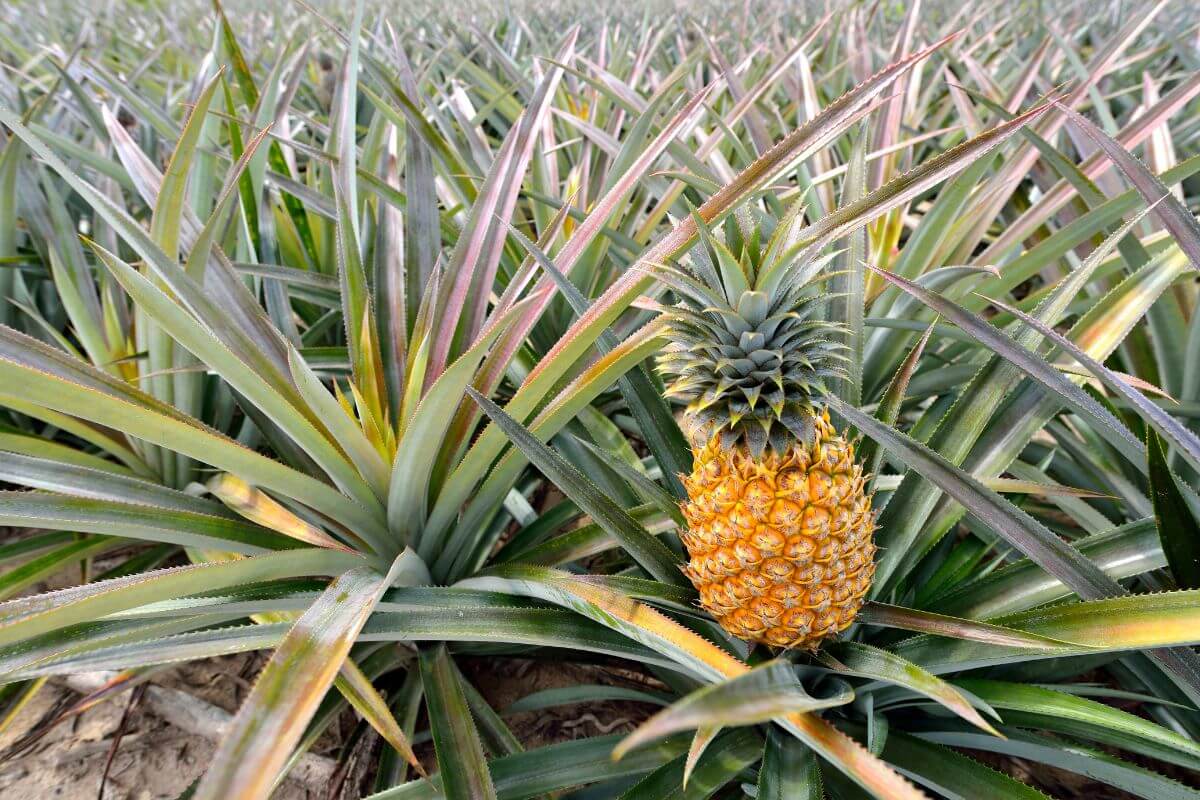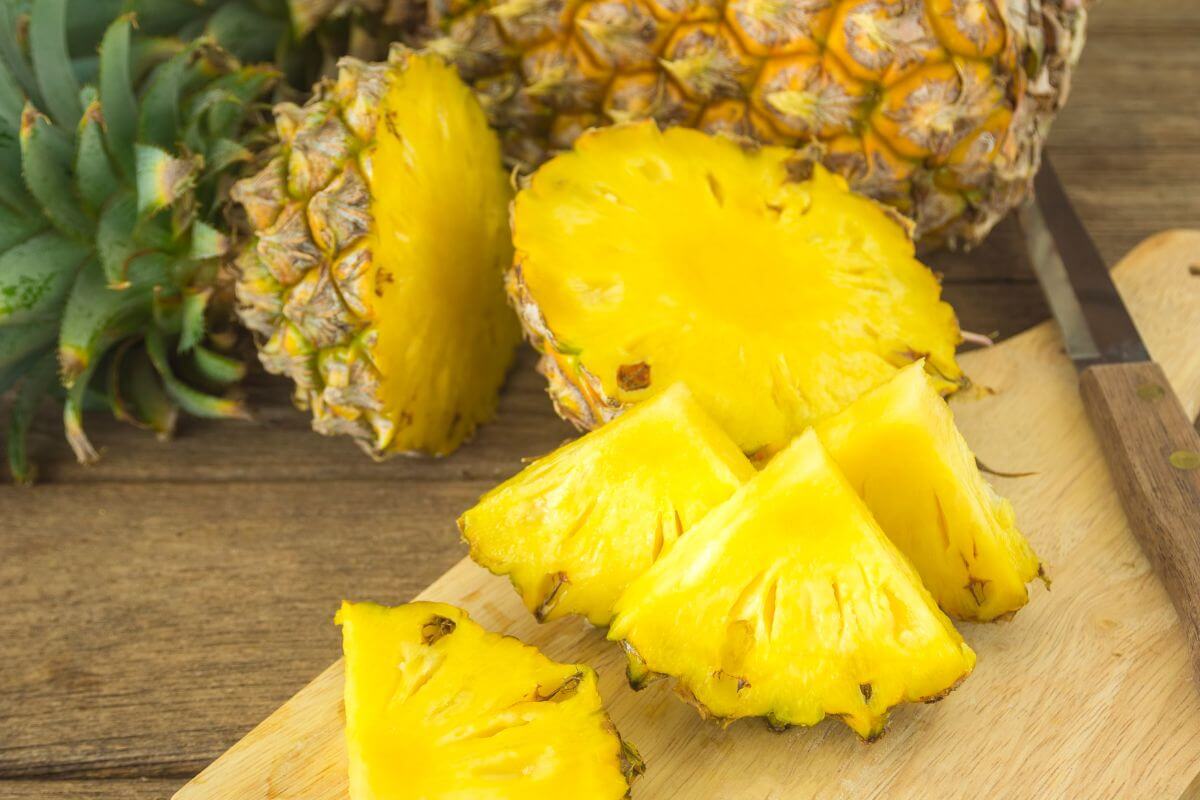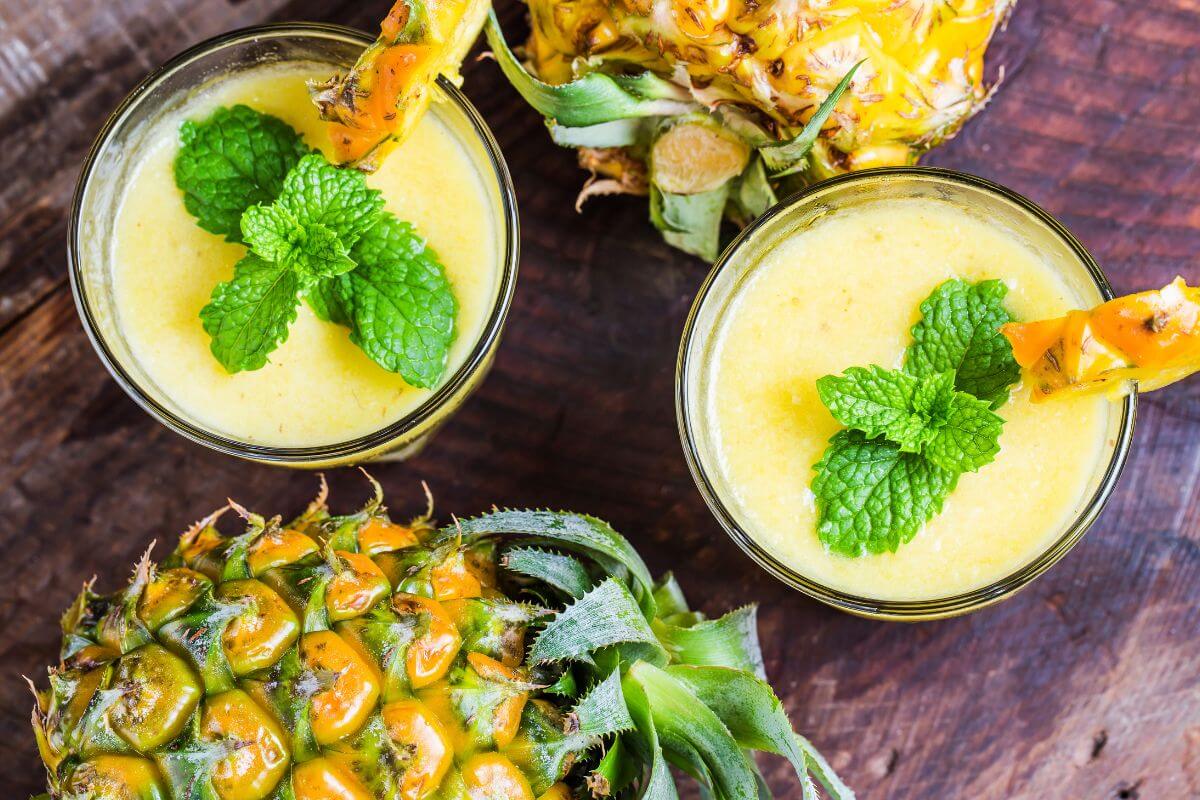Is pineapple a fruit or vegetable? You might be surprised to learn that this tropical delight is firmly in the fruit camp, despite its unique growing habits. Many people wonder about this because pineapples don’t grow on trees like most fruits, and they come from a plant that looks quite different from the typical fruit-bearing plants we know.
This guide will explore why pineapples are classified as fruits rather than vegetables. I’ll discuss their botanical characteristics, how they grow, and the delicious ways we use them in our meals. You’ll also learn about the health benefits of this sweet treat and discover some creative ways to incorporate pineapple into your diet.
Curious to find out more about this fascinating fruit? Keep reading to uncover the truth behind the pineapple and satisfy your curiosity about its classification.
- Related article: Difference Between a Fruit and a Vegetable
5 Key Takeaways on Is Pineapple a Fruit or Vegetable
- Pineapples are fruits. They grow from the flower of the plant, which is why they are classified this way.
- They are a special kind of fruit called a “multiple fruit.” This means that several flowers join together to form one fruit.
- Pineapples are not vegetables. Vegetables usually come from roots, stems, or leaves. This fact helps to show why pineapples belong in the fruit category.
- In the kitchen, we often use pineapples in sweet dishes. This is another reason they stand apart from typical vegetables.
- Eating pineapples has health benefits. They are full of nutrients that help with digestion, boost the immune system, and reduce inflammation.
Is Pineapple a Fruit or Vegetable?

Pineapples might confuse you with their name. They’re not apples and they don’t come from pine trees. Botanists call them “multiple,” “aggregate,” or “collective” fruits. This might surprise you, so let’s dive into why this is the case.
You might think it’s odd to call pineapples fruits since they don’t grow on trees and aren’t from seeds. They sprout from the ground on leafy plants. Despite this, they’re still classified as fruits. Here’s a simple rundown of why pineapples are fruits and not vegetables.
Why Pineapple Is a Fruit
First off, let’s talk about what a fruit really is. Botanically speaking, a fruit comes from the flower of a plant and usually has seeds. The pineapple grows from the plant’s flower and is made up of many tiny berries all stuck together. This makes it a composite fruit.
Fruits are often sweet or a bit sour and are great eaten fresh. Pineapples are super sweet and juicy, just like you’d expect from a fruit.
You might think pineapples are like citrus fruits because they have some similar acids, like ascorbic and citric acid. But they’re not. Pineapples come from the bromeliad family, not the citrus family.
So, when you bite into a pineapple, you’re enjoying a fruit that’s a bit different from the rest, but deliciously so.
Why the Pineapple Is Not a Vegetable
Pineapples are fruits, not vegetables, and here’s why.
Vegetables come from parts of plants like leaves, stems, roots, or bulbs. Think of lettuce, celery, carrots, and onions. Pineapples don’t fit this bill because they are the plant’s reproductive part.
Now, let’s talk about how we use them in the kitchen. We usually toss vegetables into savory dishes. Pineapples, on the other hand, star in desserts, snacks, and sweet treats. This sweet usage slots them firmly into the fruit category.
You might be surprised to learn that pineapples can grow tiny black seeds. These seeds are tucked away just beneath the peel, but we don’t usually see them because pineapples are grown for their juicy sweetness, not for planting.
So, there you have it. Pineapples tick all the boxes to be called a fruit. They don’t grow like vegetables, and we don’t eat them like vegetables. Instead, they add a sweet touch to our meals and snacks.
Pineapples Are Berries

Pineapples are berries. Yes, you read that right! Let’s dive into why pineapples get this surprising label.
Botanically speaking, a berry is a juicy fruit from a single flower with one ovary and usually many seeds. Pineapples check this box because they grow from many flowers joining together into one fruit. This makes them a “multiple berry” or “collective fruit.”
Now, pineapples are different from the small, soft-skinned berries we’re used to. They are big, tough on the outside, and made up of many fruits that create one tasty treat. The part we eat is the juicy pulp around the core, which comes from the individual flowers.
Another fruit you might be surprised to learn are berries are bananas. This is because they meet all the criteria for being a berry: they come from a single ovary, contain multiple seeds, and have a fleshy part we eat.
- Learn more: Are Bananas Veggies or Fruits?
What Are the Health Benefits of Pineapples?

Pineapple is not just a tasty tropical fruit, it also packs a punch when it comes to health benefits. Let me share why adding pineapple to your diet is a sweet deal:
- Packed With Nutrients – One cup of pineapple gives you more than 100% of your daily vitamin C. This vitamin is a champion for your immune system and keeps your skin glowing. Plus, it has manganese, which is key for strong bones and good metabolism.
- Supports Digestive Health – Thanks to bromelain, an enzyme in pineapple, this fruit helps break down proteins. It’s a great aid if you have trouble digesting protein-rich meals.
- Fights Inflammation – Bromelain also helps with swelling and bruising, making pineapple useful after injuries or surgeries. It might also ease arthritis symptoms.
- Boosts the Immune System – The vitamin C in pineapple supercharges your immune system, helping you ward off sickness.
- Speeds Up Healing and Recovery – If you’re recovering from an injury or surgery, pineapple can speed up healing due to its anti-inflammatory properties.
- Supports Bone Health – Manganese in pineapple supports bone health, potentially lowering the risk of osteoporosis.
- Aids in Iron Absorption – Eating pineapple with plant-based foods helps your body absorb more iron, fighting off deficiency, especially in vegetarian diets.
- Rich in Antioxidants – Pineapple comes loaded with antioxidants like flavonoids and phenolic acids, which fight oxidative stress and may lower the risk of chronic diseases like heart disease and cancer.
- Supports Heart Health – The potassium in pineapple helps keep your blood pressure in check, benefiting your heart.
- Aids in Weight Management – Low in calories and high in water, pineapple is a filling snack that fits perfectly into a weight management plan.
Adding pineapple to your meals not only boosts your health but also brings a burst of tropical flavor to your plate.
Different Ways to Add Pineapple to Your Diet

Here are some easy and tasty ways to add pineapple to what you eat and drink:
- Smoothies – Toss pineapple chunks into a blender with your favorite fruits, greens, and yogurt. This makes a tasty smoothie packed with vitamin C and manganese.
- Fresh Salsa – Mix diced pineapple with red bell peppers, onions, jalapeños, and lime juice. It’s a sweet and spicy salsa great with grilled meats or chips.
- Grilled Pineapple – Slice the pineapple thick and grill it until it’s sweet and caramelized. It’s a delicious side or a unique topping for burgers.
- Pineapple Popsicles – Blend fresh pineapple and freeze it in molds. You can add pineapple bits for a fun texture.
- Pineapple Parfait – Layer pineapple chunks with Greek yogurt, toasted coconut, and honey. It’s a yummy and healthy breakfast or snack.
- Detox Drinks – Blend pineapple with fruits and veggies like kale and ginger for a refreshing drink.
- Flavoring Water – Put pineapple slices in your water for a tasty twist. It’s a fun way to stay hydrated.
- Pineapple in Cooking – Add pineapple to stir-fries, rice dishes, or on pizza. It brings a sweet touch and extra nutrients.
Using pineapple this way not only makes your food taste better but also gives you the health perks of eating pineapple.
Pineapples Are Fruits Final Thoughts
Pineapples might look and sound different from what we expect fruits to be, but they’re definitely fruits. They grow close to the ground and don’t show seeds like other fruits, yet they fit all the rules to be called fruits. Their taste is sweet and juicy, making them a star in sweet dishes, which sets them apart from veggies. Plus, pineapples are special because they’re a “multiple berry” or “collective fruit,” adding a twist to our fruit ideas.
Eating pineapples is not just a treat for your taste buds. It’s also a smart move for your health. This tropical fruit comes packed with benefits, making it a delicious and nutritious addition to your meals.
Pineapples Are Fruits FAQs
1. Is Pineapple a Fruit or a Vegetable?
A pineapple is a fruit, and it’s a special kind called a berry. What makes it unique is that it’s a multiple fruit. This means it comes from many flowers that join together to create one big fruit.
2. How Is Pineapple a Fruit if It Doesn’t Have Seeds?
Pineapples are interesting because they can be seedless fruits. This happens due to a trait called self-incompatibility. When you grow just one type of pineapple alone, it can’t fertilize itself. So, it doesn’t produce seeds.
3. Is Pineapple a True Fruit?
Yes, the pineapple is a true fruit. What makes them special is that they are multiple fruits. This means they grow from many flowers joining together to form one fruit.
Read more about other fruits and vegetables:

